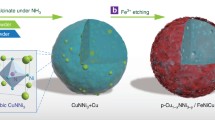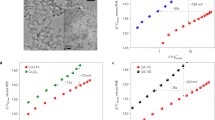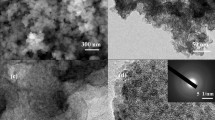Abstract
Oxygen evolution reaction (OER) during water splitting majorly based on the structure and nature of the electrocatalyst. Perovskite oxides (ABO3) have a flexible structure and range of physicochemical features that make them interesting for the present study. Therefore, scientists are interested in using electrocatalyst Perovskite oxides (ABO3) for OER. Nanostructures and amorphous patterns can appear when cations from the perovskite matrix are leached away from the A site. One of the most challenging problems is gaining enormous active amorphous subjects from cations in the B site rather than simply dissolving cations in the A site. In the present study, the crystalline perovskite (DyNiO3) has been fabricated, which is converted into an amorphous nanostructured comparative to NiO, and characterized via numerous analytical characterization methods to investigate the structural, morphological, and textural characteristics. The designed substance is then investigated for electrochemical characterizations to evaluate the overpotential, Tafel slope, and durability. Among all, DyNiO3 responses have a slight overpotential (η) of 265 mV and a low Tafel slope of 78 mV/dec with greater durability of 49 h. The efficient outcomes of the DyNiO3 are because of the grater valence state of Ni3+ containing edge splitting octahedral-frameworks, which are bordering by interstitial deformed octahedral Dy3+ ion. This research improves perovskite oxides function as catalysts and can be applied to developing enhanced OER electrocatalysts and other energy applications in the near future.
Graphical Abstract

DyNiO3 was prepared and then deposited on the substrate such as nickel foam. The deposited nickel foam was then employed for the electrochemical measurements such water splitting applications. The chronoamperometric text was performed to conform the stability of the material. The material remained stable upto 84 h.
Highlights
-
The DyNiO3 was fabricated via simple hydrothermal method.
-
The fabricated material is characterized via numerous analytical characterization.
-
The designed substance is then investigated for electrochemical characterizations to evaluate the overpotential, Tafel slope and durability.
-
The DyNiO3 responses a low overpotential of 265 mV and a low Tafel slope of 78 mV/dec with greater durability of 49 h.





Similar content being viewed by others
Data availability
The datasets generated during and/or analysed during the current study are available from the corresponding author on reasonable request.
References
Khan K, Tareen AK, Aslam M, Zhang Y, Wang R, Ouyang Z, Gou Z, Zhang H (2019) Recent advances in two-dimensional materials and their nanocomposites in sustainable energy conversion applications. Nanoscale 11:21622–21678
Li Z, Achenie LE, Xin H (2020) An adaptive machine learning strategy for accelerating discovery of perovskite electrocatalysts. ACS Catal 10:4377–4384
Liu Q, Zhao H, Jiang M, Kang Q, Zhou W, Wang P, Zhou F (2020) Boron enhances oxygen evolution reaction activity over Ni foam-supported iron boride nanowires. J Mater Chem A 8:13638–13645
Nisa MU, Manzoor S, Abid AG, Tamam N, Abdullah M, Najam-Ul-Haq M, Al-Buriahi M, Alrowaili Z, Mahmoud ZM, Ashiq MNJF (2022) CdSe supported SnO2 nanocomposite with strongly hydrophilic surface for enhanced overall water splitting. Surf Interface 321:124086
Quaino P, Juarez F, Santos E, Schmickler W (2014) Volcano plots in hydrogen electrocatalysis–uses and abuses. Beilstein J Nanotechnol 5:846–854
Abid AG, Manzoor S, Ahmad Z, Hussain D, Mersal GA, Azab IH El, Elnaggar AY, El-Nasser KS, Taha T, Ashiq MN (2022) Facile synthesis of scheelite-type NdOsO4 directly grown on carbon cloth for oxygen evolution reaction. J Solid State Electrochem 1–10.
Rashid AR, Abid AG, Manzoor S, Mera A, Al-Muhimeed TI, AlObaid AA, Shah SN, Ashiq MN, Imran M, Najam-Ul-Haq M (2021) Inductive effect in Mn-doped ZnO nanoribon arrays grown on Ni foam: A promising key for boosted capacitive and high specific energy supercapacitors. Ceram Int 47:28338–28347
Diaz-Morales O, Ledezma-Yanez I, Koper MT, Calle-Vallejo F (2015) Guidelines for the rational design of Ni-based double hydroxide electrocatalysts for the oxygen evolution reaction. ACS Catal 5:5380–5387
Lei C, Zhou W, Feng Q, Lei Y, Zhang Y, Chen Y, Qin J (2019) Charge engineering of Mo2C@ defect-rich N-doped carbon nanosheets for efficient electrocatalytic H2 evolution. Nanomicro Lett 11:1–10
He T, Matta SK, Will G, Du A (2019) Transition‐metal single atoms anchored on graphdiyne as high‐efficiency electrocatalysts for water splitting and oxygen reduction, Small. Methods 3:1800419
Wang HY, Hsu YY, Chen R, Chan TS, Chen HM, Liu B (2015) Ni3+‐induced formation of active NiOOH on the spinel Ni–Co oxide surface for efficient oxygen evolution reaction. Adv Energy Mater 5:1500091
Y Li (2021) Morphology and interface design of nickel-based heterostructures for water splitting electrocatalysis (2021).
Li Y, Zhao C (2016) Iron-doped nickel phosphate as synergistic electrocatalyst for water oxidation. Chem Mater 28:5659–5666
Vij V, Sultan S, Harzandi AM, Meena A, Tiwari JN, Lee W-G, Yoon T, Kim KS (2017) Nickel-based electrocatalysts for energy-related applications: oxygen reduction, oxygen evolution, and hydrogen evolution reactions. Acs Catal 7:7196–7225
Kukkapalli P (2015) Facile sol-gel molten salt synthesis of double perovskite La2NiMnO6 as an electrocatalyst for oxygen evolution reactions, The University of Texas Rio Grande Valley.
Majee R, Parvin S, Arif Islam Q, Kumar A, Debnath B, Mondal S, Bhattacharjee S, Das S, Kumar A, Bhattacharyya S (2022) The Perfect Imperfections in Electrocatalysts. Chem Rec e202200070
Wang X, Li W, Xiong D, Petrovykh DY, Liu L (2016) Bifunctional nickel phosphide nanocatalysts supported on carbon fiber paper for highly efficient and stable overall water splitting. Adv Funct Mater 26:4067–4077
Fu G, Wen X, Xi S, Chen Z, Li W, Zhang J-Y, Tadich A, Wu R, Qi D-C, Du Y (2018) Tuning the electronic structure of NiO via Li doping for the fast oxygen evolution reaction. Chem Mater 31:419–428
Dias JA, Andrade Jr MA, Santos HL, Morelli MR, Mascaro LH (2020) Lanthanum‐based perovskites for catalytic oxygen evolution reaction. ChemElectroChem 7:3173–3192
Wei Y, Zheng Y, Hu Y, Huang B, Sun M, Da P, Xi P, Yan C-H (2022) Controlling the Cation Exsolution of Perovskite to Customize Heterostructure Active Site for Oxygen Evolution Reaction, ACS Applied Materials & Interfaces
Chen G, Zhu Y, Chen HM, Hu Z, Hung SF, Ma N, Dai J, Lin HJ, Chen CT, Zhou W (2019) An amorphous nickel–iron‐based electrocatalyst with unusual local structures for ultrafast oxygen evolution reaction. Adv Mater 31:1900883
Chu D, Li J (2020) Earth-Abundant Ni-Mo-S based bifunctional electrocatalyst for efficient water splitting. ECS Trans 97:575
Zeng L, Cui X, Shi J (2018) A facile strategy for ultrasmall Pt NPs being partially-embedded in N-doped carbon nanosheet structure for efficient electrocatalysis. Sci China Mater 61:1557–1566
Srinivasa N, Shreenivasa L, Adarakatti PS, Hughes JP, Rowley-Neale SJ, Banks CE, Ashoka S (2019) In situ addition of graphitic carbon into a NiCo2O4/CoO composite: enhanced catalysis toward the oxygen evolution reaction. RSC Adv 9:24995–25002
Abid AG, Ashiq MF, Alfryyan N, Manzoor S, Nisa MU, Al-Buriahi M, Alomairy S, Alrowaili Z, Ashiq MN (2022) Stainless steel supported NiS/CeS nanocomposite for significantly enhanced oxygen evolution reaction in alkaline media. J Solid State Electrochem 1–12
Taylor A, Sinclair H (1945) On the determination of lattice parameters by the Debye-Scherrer method. Proc Phys Soc (1926-1948) 57:126
Samoila P, Slatineanu T, Postolache P, Iordan A, Palamaru M (2012) The effect of chelating/combustion agent on catalytic activity and magnetic properties of Dy doped Ni–Zn ferrite. Mater Chem Phys 136:241–246
Abdullah M, John P, Ashiq MN, Manzoor S, Ghori MI, Nisa MU, Abid AG, Butt KY, Ahmed S (2022) Development of CuO/CuS/MnO2 ternary nanocomposite for visible light-induced photocatalytic degradation of methylene blue. Nanotechnol Environ Eng 1–11
Wu Z, Zou Z, Huang J, Gao F (2018) Fe-doped NiO mesoporous nanosheets array for highly efficient overall water splitting. J Catal 358:243–252
Liu G, Gao X, Wang K, He D, Li J (2016) Uniformly mesoporous NiO/NiFe2O4 biphasic nanorods as efficient oxygen evolving catalyst for water splitting. Int J Hydrog Energy 41:17976–17986
Wan Z, He Q, Chen J, Isimjan TT, Wang B, Yang X (2020) Dissolution-regrowth of hierarchical Fe-Dy oxide modulates the electronic structure of nickel-organic frameworks as highly active and stable water splitting electrocatalysts. Chin J Catal 41:1745–1753
Rodney JD, Deepapriya S, Robinson MC, Raj CJ, Perumal S, Kim BC, Krishnan S, Das SJ (2021) Dysprosium doped copper oxide (Cu1-xDyxO) nanoparticles enabled bifunctional electrode for overall water splitting. Int J Hydrog Energy 46:27585–27596
Weng B, Xu F, Wang C, Meng W, Grice CR, Yan Y (2017) A layered Na1− xNiyFe1− y O2 double oxide oxygen evolution reaction electrocatalyst for highly efficient water-splitting. Energy Environ Sci 10:121–128
Ma Y, Mu G-M, Miao Y-J, Lin D-M, Xu C-G, Xie F-Y, Zeng W (2022) Hydrangea flower-like nanostructure of dysprosium-doped Fe-MOF for highly efficient oxygen evolution reaction. Rare Met 41:844–850
Rodney JD, Deepapriya S, Das SJ, Robinson MC, Perumal S, Katlakunta S, Sivakumar P, Jung H, Raj CJ (2022) Boosting overall electrochemical water splitting via rare earth doped cupric oxide nanoparticles obtained by co-precipitation technique. J Alloy Compd 921:165948
Zhang H, Lv Y, Chen C, Lv C, Wu X, Guo J, Jia D (2021) Inter-doped ruthenium–nickel oxide heterostructure nanosheets with dual active centers for electrochemical-/solar-driven overall water splitting. Appl Catal B: Environ 298:120611
Fominykh K, Feckl JM, Sicklinger J, Döblinger M, Böcklein S, Ziegler J, Peter L, Rathousky J, Scheidt EW, Bein T (2014) Ultrasmall dispersible crystalline nickel oxide nanoparticles as high‐performance catalysts for electrochemical water splitting. Adv Funct Mater 24:3123–3129
Acknowledgements
The authors express their gratitude to Princess Nourah bint Abdulrahman University Researchers Supporting Project number (PNURSP2023R132), Princess Nourah bint Abdulrahman University, Riyadh, Saudi Arabia. Deanship of Scientific Research at King Khalid University is greatly appreciated for funding this work under grant number R.G.P.1/274/43.
Funding
Princess Nourah bint Abdulrahman University Researchers Supporting Project number (PNURSP2023R132), Princess Nourah bint Abdulrahman University, Riyadh, Saudi Arabia. Deanship of Scientific Research at King Khalid University is greatly appreciated for funding this work under grant number R.G.P.1/274/43.
Author information
Authors and Affiliations
Contributions
SA, SM, AGA, MUN: Worked in the laboratory i.e., experimental work done and also wrote the manuscript, development or design of methodology; creation of models, RYK: Visualization. MA, MMA, SAMA: Writing, review, and editing. HMTF: Supervision.
Corresponding authors
Ethics declarations
Conflict of interest
The authors declare no competing interests.
Ethical approval
Yes this article compliance with ethical standards of journal.
Additional information
Publisher’s note Springer Nature remains neutral with regard to jurisdictional claims in published maps and institutional affiliations.
Rights and permissions
Springer Nature or its licensor (e.g. a society or other partner) holds exclusive rights to this article under a publishing agreement with the author(s) or other rightsholder(s); author self-archiving of the accepted manuscript version of this article is solely governed by the terms of such publishing agreement and applicable law.
About this article
Cite this article
Aman, S., Alanazi, M.M., Abdelmohsen, S.A.M. et al. An ultrafast oxygen evolution reaction catalyzed by an amorphous Nickel–Dysprosium-based electrocatalyst with extraordinary spatial morphology. J Sol-Gel Sci Technol 106, 226–235 (2023). https://doi.org/10.1007/s10971-023-06058-1
Received:
Accepted:
Published:
Issue Date:
DOI: https://doi.org/10.1007/s10971-023-06058-1




